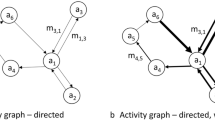Abstract
A survey on the daily movement behavior of the people residing in the territory of the Municipality of Pisa, Italy, was carried out in October 2002. This work is aimed at modeling the distance covered and the number of trips taken in a day as functions of several individual characteristics. In order to take the potential intra-family and intra-area correlation of the observations into account, multilevel models are estimated. We use two and three level hierarchical linear and Poisson models to estimate the number of daily trips taken by an individual. Likelihood ratio tests indicate the movement behavior in 1 day is more alike for individuals within a family than for individuals from different families.

Similar content being viewed by others
References
Baccaïni B (1994) Migratory behavior and life cycles. Espace Popul Soc 3:61–74
Baccaïni B (1997) Commuting and residential strategies in the Î le-de-France: individual behavior and spatial constraints. Environ Plan A 29:1801–1829
Bottai M (2003) Confidence regions when the Fisher information is zero. Biometrika 90(1):73–84
Bottai M, Barsotti O (1994) In: Lo spazio e la sua utilizzazione. Eds. Franco Angeli, Milano
Bottai M, Orsini N (2004) Confidence intervals for the variance component of random-effects linear models. Stata J 4(4):429–435
Breslow NE, Clayton DG (1993) Approximate inference in generalized linear mixed models. J Am Stat Assoc 88:9–25
Camstra R (1996) Commuting and gender in a lifestyle perspective. Urban Stud 33P:283–300
Casella G, Berger RL (1990) Statistical inference. Duxbury Press, Belmont
Cevero R, Wu K-L (1997) Polycentrism, commuting, and residential location in the San Francisco Bay area. Environ Plan A 29:865–886
Crainiceanu CM, Ruppert D (2004) Likelihood ratio tests in linear mixed models with one variance component. J R Stat Soc B 66:165–185
Dampster AP, Laird NM, Rubin DB (1977) Maximum likelihood from incomplete data via the EM algorithm. J R Stat Soc B 39:1–38
Johnston-Anumonwo (1992) The influence of household type and gender differences in the work trip distance. Prof Geogr 44:161–169
Madden JF (1981) Why women work closer at home. Urban Stud 18:181–194
McCulloch CE, Searle SR (2001) Generalized, linear and mixed models. Wiley, New York
Rabe-Hesketh S, Pikles A, Skrondal A (2002) GLLAMM manual. Technical Report 2001/01, Department of Biostatistics and Computing, Institute of Psychiatry, King’s College, London
Raudeumbush SW, Bryk AS (2002) Hierarchical linear models. Sage, London
Ruppert D, Wand MP, Carroll RJ (2003) Semiparametric regression. Cambridge University Press, Cambridge
Searle SR, Casella G, McCullcoh CE (1992) Variance components. Wiley, New York
Self SG, Liang KY (1987) Properties of maximum likelihood estimators and likelihood ratio test under nonstandard conditions. J Am Stat Assoc 82:605–610
Snijders TAB, Bosker RJ (1999) Multilevel analysis. Sage, London
Tkocz Z, Kristensen G (1994) Commuting distances and gender: a spatial urban model. Geogr Analy 26:1–14
Vickerman RW (1984) Urban and regional change, migration and commuting—the dynamics of workplace, residence and transport choice. Urban Stud 21:15–29
White MJ (1988) Location choice and commuting behavior in cities with decentralized employment. J Urban Econ 24:129–152
Author information
Authors and Affiliations
Corresponding author
Rights and permissions
About this article
Cite this article
Bottai, M., Salvati, N. & Orsini, N. Multilevel models for analyzing people’s daily movement behavior. J Geograph Syst 8, 97–108 (2006). https://doi.org/10.1007/s10109-006-0017-x
Received:
Accepted:
Published:
Issue Date:
DOI: https://doi.org/10.1007/s10109-006-0017-x




